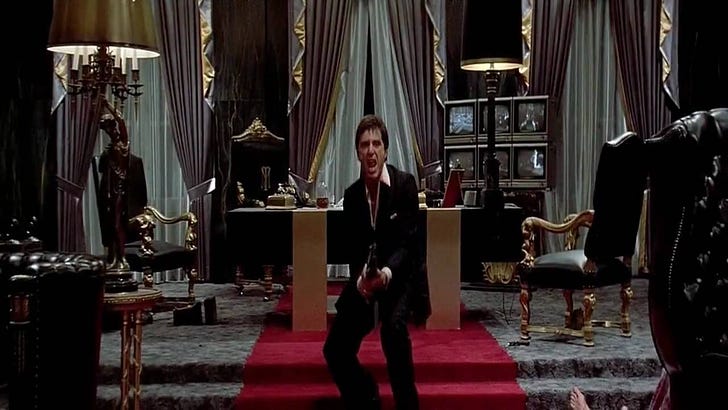"Say hello to my little friend!" the famous line from Tony Montana in Scarface, unleashing chaos as he clings to his crumbling empire.
Like Tony, high on his own supply and believing in his own invincibility, President Trump sees tariffs as his "little friend"—a weapon that he thinks will make the U.S. economy stronger. But just as Tony’s empire collapsed into destruction, history has shown that tariffs lead not to prosperity but to economic pain. According to Chief Market Strategist Greg Crennan of Golden Coast Consultants, the impending global trade war, scheduled to commence on April 2, 2025, could have far-reaching consequences for both the U.S. and global economies. As Sunday evening Stock Market futures open (March 30, 2025), traders are not waiting for the outcome; the Nasdaq has already experienced a decline of -1.3%.
The last time tariffs of this magnitude were implemented, U.S. GDP growth contracted by over -3%, unemployment soared past 10%, and the stock market collapsed by over -30% in just a few years. Historical data shows that when tariffs were enacted on a large scale, the S&P 500 saw declines of -2 to -40%, foreign direct investment fell by over -50%, and industrial production shrank by more than -25%.
A History of Economic Pain
In our previous articles found here ( Tariffs Dancing with the devil, Tariff Storm, and The Return of Tariffs ) we reference President Hoover Tariffs which sparked fear in the Stockmarket in 1929 and started the depression in the 1930s. The U.S. has played this game before, and it never ends well. Consider the early 1920s—a period often overlooked yet packed with lessons about the dangers of protectionism. The Emergency Tariff Act of 1921 was implemented to shield American farmers from European agricultural recovery. However, rather than securing prosperity, it contributed to the severe deflationary downturn known as the Forgotten Depression, with prices collapsing by -36%, industrial production falling over -30%, and unemployment spiking to nearly 12% by 1921. The agricultural sector, which the tariffs were meant to protect, saw farm incomes plummet by over -50%, leading to widespread bankruptcies and foreclosures. The Dow Jones Industrial Average (DJIA) fell by -47% between 1920 and 1921, erasing nearly half the market's value in just over a year.
Then came the Fordney-McCumber Tariff Act of 1922, which aimed to protect U.S. industries and agriculture. But instead of fortifying the domestic economy, it suffocated global trade, making it harder for European nations to repay war debts. This stifling of trade led to another recession in 1923–1924, with manufacturing output dropping by 15% and foreign imports declining by nearly 25%. U.S. GDP growth slowed from 6% in 1922 to just 1% in 1923. High tariffs made it nearly impossible for foreign nations to earn U.S. dollars through trade, and the economic fallout soon spiraled into the restrictive National Origins Act of 1924, which limited immigration under the false premise of protecting American jobs. In reality, these policies further slowed economic growth, causing a prolonged period of stagnation and a decline of 20% in U.S. stock market capitalization.
Tariffs Don't Cause Inflation—Money Printing Does
One of the biggest misconceptions today is that tariffs drive inflation. However, history tells a different story. When analyzing periods of widespread inflation in the U.S., tariffs have had little to no role in driving prices higher. Instead, inflation has consistently been linked to monetary policy and massive increases in the money supply. Conversely, when prices have drastically declined, it has almost always been the result of tariffs and trade wars collapsing economic activity. The historical evidence is clear—tariffs do not create inflation, but they do cause recessions and economic downturns.
Since the Federal Reserve Act of 1913, CPI inflation has only exceeded 5% on a year-over-year basis during specific periods—none of which were driven by tariffs. Instead, these inflationary spikes were caused by war, supply disruptions, and most importantly, massive increases in the money supply:
Keep reading with a 7-day free trial
Subscribe to The Coastal Journal to keep reading this post and get 7 days of free access to the full post archives.








